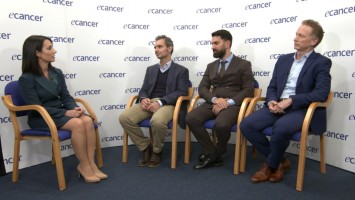The SCOT study is a large international study looking at the duration of adjuvant chemotherapy treatment for colorectal cancer. For the last decade adjuvant chemotherapy for colorectal cancer has been six months’ oxaliplatin containing chemotherapy and that has been standard throughout the world for stage 3 colon cancer. We know that with stage 3 colon cancer if you’re receiving adjuvant chemotherapy treatment one of the long-term side effects of chemotherapy treatment is peripheral neuropathy; this can be quite disabling to patients and can be long-lasting. We know that the dose of oxaliplatin is important because the instance of neuropathy increases with increasing dose of oxaliplatin. Therefore there was an idea that if we could reduce the duration of chemotherapy treatment from six months, which is the standard, to three months without significantly reducing efficacy we would reduce the side effect profile and that would be better for patients.
So SCOT was set up as a non-inferiority trial. The basis of that non-inferiority was to exclude more than a 2.5% fall in three year disease free survival with the three month arm compared to the six month arm. In order to meet the non-inferiority criteria set within SCOT that would have required 9,500 patients which would have given us 2,750 events. In the event, due to slower than anticipated recruitment, we recruited 6,088 patients over a 5½ year period and that was from six countries and 244 centres.
What we have been able to show with the SCOT study is that for the overall population then three months’ treatment was non-inferior to six months’ treatment. Three year disease free survival for the three month arm was 76.7% and for the six month arm was 77.1%, an absolute difference of 0.4%. As I said, that met its non-inferiority criteria.
SCOT was not the only study looking at treatment duration, globally there were six studies and they were the SCOT study, an Italian study, an American study, a French study, a Greek study and a Japanese study. There was a collaboration called the IDEA collaboration to combine all six studies and do a meta-analysis.
Further than the three year survival what does that mean for savings in terms of costs and benefits to quality of life for patients on the three month rather than six month course?
If patients have three months’ treatment rather than six months’ treatment there will be less peripheral neuropathy. There will also be significant savings, probably for each patient. The savings will be for the patient in terms of improved quality of life and less side effects; for the health service there will be savings because there will be a reduction in treatment costs and in hospital appointments. It’s difficult to quantify that exactly but probably in the order of between £5,000-10,000 per patient.
Just to check, the three month course, is that just shorter or is the intensity of treatment increased as well?
No, the chemotherapy regimen is exactly the same, it’s the duration of treatment, three months versus six months, that was looked at.
Were any other side effects apart from peripheral neuropathy assessed?
We’ve looked at all of the side effects and in terms of the grade 3/4 side effects the only side effect which was much worse in the six month arm compared to the three month arm was peripheral neuropathy.
The other thing I’d like to say is that within SCOT and also within IDEA two findings have come out. One in both the SCOT study and IDEA, you could choose which chemotherapy treatment was given, whether it was oxaliplatin with capecitabine, the CAPOX regimen, or oxaliplatin with 5FU, the FOLFOX regimen. In metastatic disease they’ve been shown to be equivalent but in the adjuvant setting the evidence for three months’ treatment being equivalent to six months’ treatment is much stronger for CAPOX than it is for FOLFOX which was a surprise but that has been consistent across all of the studies in IDEA.
The other thing that has come out from IDEA is that when we are looking at stage 3 patients it now appears that we can subdivide these into two different groups – a low risk stage 3 patient and a high risk stage 3 patient. Low risk stage 3 has been defined as T stage 1-3 with N1 disease whereas high risk is T4 or N2 disease. If you look at the low risk stage 3 patients in SCOT the three year survival was in the order of 85% whereas if you look at the high risk population in SCOT the three year survival is in the order of 64% so there’s a big difference between those two groups. If we look at the low risk stage 3 disease then in SCOT we were able to show non-inferiority between three months’ and six months’ treatment whereas although the absolute difference was small at 2.8% in three year disease free survival with high risk stage 3 disease that didn’t meet the non-inferiority criteria.
So what I would say is that SCOT met the non-inferiority criteria for the overall population but the evidence was strongest for patients receiving CAPOX chemotherapy and was also strongest for patients with low risk stage 3 disease. So from the basis of SCOT we would say that for patients with low risk stage 3 disease they can probably have three months’ treatment rather than six months’ treatment. Those with high risk stage 3 disease, patients need to be counselled because there is a small difference in overall survival by having six months but that comes at a cost of significant increased toxicity. The choice as to whether you have three months’ or six months’ treatment for those patients needs to be discussed with the patient.








